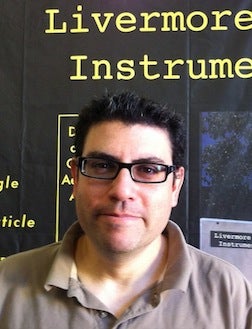runs Livermore Instruments Inc., a company that he and his colleagues formed to commercialize a technology that he began working on as a Summer Undergraduate Research Fellow at the University of California, Riverside in the mid 1990s. The technology, called Single Particle Aerosol Mass Spectrometry, or SPAMS, is a way of instantaneously analyzing tiny particles that are found either in air or in a liquid. A SPAMS system pulls the particles into itself, one at a time, and uses a high power laser to blow them into ions that are analyzed by time-of-flight mass spectrometry. The data is automatically analyzed using methods that David developed for his dissertation research at UCR.
The original application of the technology, when it was developed at UCR, was the analysis of air pollution in Southern California. Since then, David’s colleagues have broadened its application areas to include, among other things, the real-time identification of microorganisms and the qualification of inhaled pharmaceuticals.
“When I arrived at UCR, I had never been west of Pittsburgh, Pennsylvania and I had no concept of what it really meant to do Chemistry. California was wonderful and Chemistry was very far removed from the classroom discipline that I’d been training in. I was working with the graduate students late at night as they were laying out and testing circuits, aligning lasers, running experiments and I asked, naively, ‘You guys actually do stuff?’ I was hooked.”
By the end of the summer, David was offered a spot in graduate school by his advisor, Dr. Kimberly A. Prather and he opted to go to UCR in lieu of medical school, a choice that he would not have had to make now that UCR has established a new medical school. He spent the next five years working with his colleagues to develop the Aerosol Time-of-Flight Mass Spectrometer into a field portable instrument, then fielding the prototype instruments, and finally developing the tools to analyze the ATOFMS data. During the process, he also worked with representatives of TSI, Inc. to transfer the technology to be a commercial product. He filed his dissertation, The Analysis of Aerosol Time-of-Flight Mass Spectrometry Data in early 2001.
After graduate school, David was recruited by a former postdoctoral fellow who he had worked for at UCR to be a postdoc himself at Lawrence Livermore National Laboratory. In his new laboratory, they bought three of the commercial ATOFMS machines from TSI and converted them to biodefense systems. One of his assignments involved him deploying a biodefense system that he had codeveloped to Florida in response to the postal anthrax attacks of the autumn of 2001 and wearing a bunny suit for several weeks as he and his team inspected the U.S. Mail for anthrax spores. He worked at LLNL until the summer of 2008 when he and several colleagues formed Livermore Instruments to commercialize the technology that they had developed.
Livermore Instruments started in one of the most challenging business environments of the past seventy years but the lessons learned in cost containment and efficient use of resources are still paying off. Since being founded, Livermore Instruments secured investment, filed patents, won contracts to construct and deliver SPAMS 3.0s, won a Federal Qualifying Therapeutic Discovery Project award and was named as a runner up in the regional finals of the Global Security Challenge, so things went well enough despite the tough times. Livermore Instruments is currently based in Oakland, California and manufactures the SPAMS 3.0 Single Particle Aerosol Mass Spectrometer in the United States but running the company has taken David all over the world as they have delivered goods and services to seven countries. “It’s very gratifying to nail a crate shut with a product inside that says “Made in USA”, says David.
As a profession, David compares science to acting or art in that it’s a very competitive field but one where, once a person has been “bit by the bug”, no other career can be fulfilling. David still remembers getting hooked twenty years ago at UCR.
